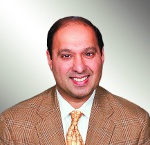 Spine centers across the country are evolving to meet a wider array of patient needs, and learning how to direct patients to the best specialist for their care from their very first visit.
Spine centers across the country are evolving to meet a wider array of patient needs, and learning how to direct patients to the best specialist for their care from their very first visit.
"The wonderful thing about the spine center concept is that patients have the opportunity to not only see myself, but the entire team, including the rehabilitation and pain management specialists. This adds to their care so now there is a multidisciplinary team of specialists working on the same problem," says Purnendu Gupta, MD, Director of the Chicago Spine Center at Weiss Memorial Hospital and Clinical Professor of Orthopedic Surgery at University of Illinois at Chicago. "Each of us has experience and insight based on our training and specialty, and this allows us to perform a more comprehensive evaluation of the patient."
Collaborative approach
The specialists at the Chicago Spine Center at Weiss have a collaborative working relationship where they communicate in real time about their patients and work together to develop treatment plans. "There is an exchange of ideas; we sit together and look at the films while assessing the patient," says Dr. Gupta. "The patient really benefits because we gather all of our strengths to come up with the best treatment approach."
The Center's goal — which hasn't been achieved yet — is for the patient to arrive and see a specialist, and then receive any needed interventional treatment the same day, if possible. For now, specialists at the Center are working on better centralizing the patient flow process between physicians.
"We recently all joined the center with the shared vision that if the patient calls, they will be triaged to the right specialist," says Dr. Gupta. "Right now, many of the patients are directly referred to me and we triage them. But in the future, a nurse would speak to them first for initial triage and direct the patient to a pain management specialist, physiatrist or myself if surgery is the best option."
The referred patient would then fit seamlessly into the patient flow; in the future, the triage nurse would then organize their previous medical history and imaging studies to prepare for the visit.
Data collection
Every Friday a multidisciplinary team meets to clinically discuss patients, work on research and plan clinical studies. There are also administrative meetings the surgeons attend to stay abreast of organizational changes. Eventually, Dr. Gupta and his team hope to form an outcomes database and registry for data collection.
"Then we can look back and see what protocol worked best with similar patients in the past," says Dr. Gupta. "We can also utilize the relevant data for research projects and potentially publication. Day-to-day, the registry will help us do a better job of taking care of our patients."
To gather information in a database, Dr. Gupta would like to use an iPad-driven questionnaire database patients could complete while they are in the waiting room preparing for their visit. Based on their responses, the patient would be directed to more focused, relevant questions that really could help clinicians understand their spinal condition.
"It's time consuming, but most of the time people would be able to complete the questionnaire in the exam room," says Dr. Gupta. "Not every patient is motivated to do the surveys, but we'll encourage clinic coordinators to help push data gathering forward."
Challenging insurance companies
One of the biggest challenges Dr. Gupta has faced over the past few years is insurance company approval for imaging studies, repeat studies and surgery. There has been a focus among insurers to eliminate wasteful tests, but imaging studies are often necessary for complex spine patients. When insurance companies resist, practice staff members and even the physicians, spend extra time on the phone with the insurance companies gaining approval.
"When we have a situation where the patient needs surgery and we require an imaging study before the procedure, it becomes a real challenge and expense of manpower and long hours to get these procedures approved," says Dr. Gupta. "Unfortunately we are getting more delays from payers."
When a procedure is denied, the staff will usually be able to reschedule the procedure after some delay. But with more data, spine surgeons are finding ways to prove the value of their procedures, and how they're cost-effective. They'll also be able to treat patients with more confidence in their outcomes.
"When patients are in pain and upset, it is reassuring to show them the data. For example,90 percent of patients with the same problem get better based on the literature, and we demonstrate to them that perhaps 92 percent of the patients at our center with that problem have gotten better, based on our outcomes," says Dr. Gupta. "Patients often are worried and sometimes panicked they will never get better. They are fearful and upset about their pain and lack of function. But with this database technology and outcomes, we will be able to put them more at ease."
More Articles on Spine Surgery:
Medicare Data Released: How Data Transparency is Transforming the Spine Field
5 Findings on O-arm Pedicle Screw Placement in Spine Surgery
5 Findings on Lumbar Interbody Fusion Alignment


